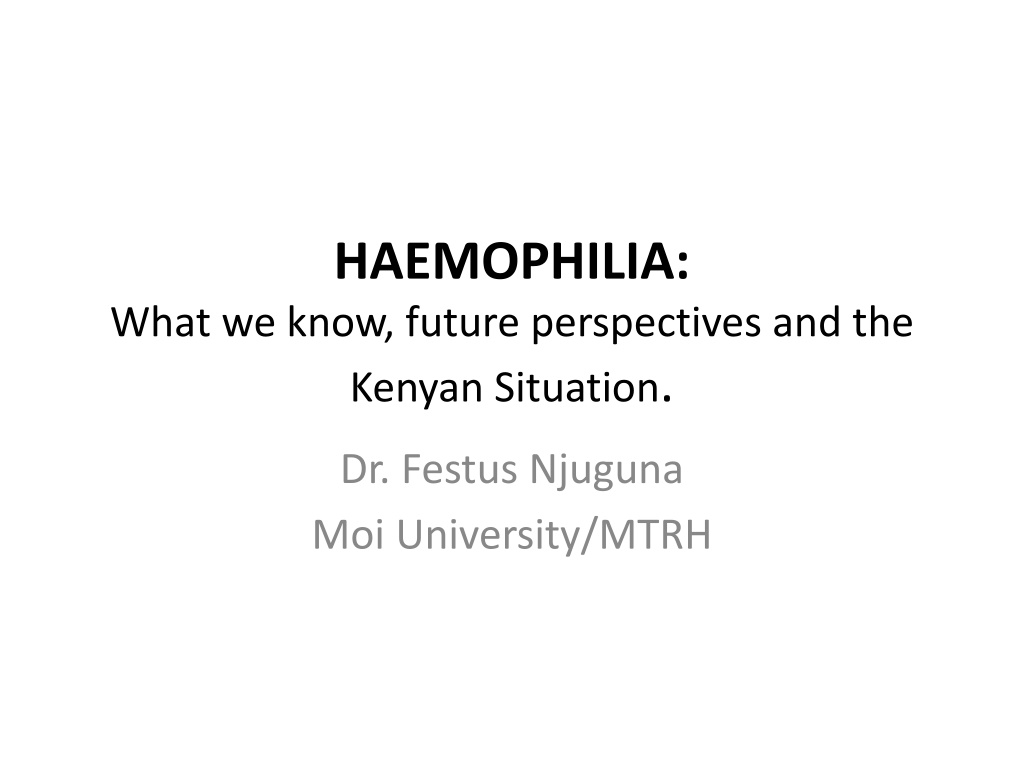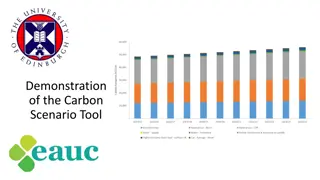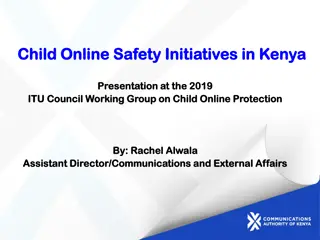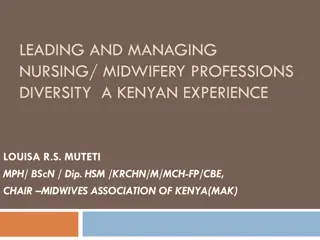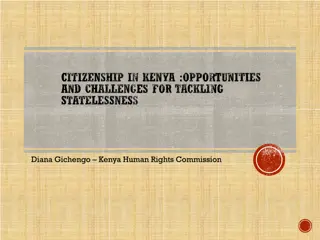Understanding Haemophilia: Current Knowledge, Future Perspectives, and the Kenyan Scenario
Haemophilia is a genetic disorder affecting 1 in 10,000 deliveries, with joint bleeds being a common presentation. Bleeding episodes into joints can lead to chronic issues like synovial hypertrophy. Laboratory evaluation involves APTT testing and factor assays, with treatment including factor replacement and physiotherapy. Prophylactic therapy is essential to maintain factor levels and prevent complications, especially before surgery.
Download Presentation

Please find below an Image/Link to download the presentation.
The content on the website is provided AS IS for your information and personal use only. It may not be sold, licensed, or shared on other websites without obtaining consent from the author. Download presentation by click this link. If you encounter any issues during the download, it is possible that the publisher has removed the file from their server.
E N D
Presentation Transcript
HAEMOPHILIA: What we know, future perspectives and the Kenyan Situation. Dr. Festus Njuguna Moi University/MTRH
INTRODUCTION Genetic X-linked disorder Haemophilia A and B Affects 1 per 10,000 deliveries 30% of cases due to new mutations Haemophilia A more common
Range of Factor VIII or IX Activity High levels found in pregnancy Normal range of FVIII & IX ~1/3 of carriers have levels in low or below normal range Level above which bleeding after injury is unlikely Mild hemophilia Moderate hemophilia Severe hemophilia
INTRODUCTION Joint bleeds ( knee, ankle) is the commonest presentation Also causes muscle bleeds, intracranial bleeding, GIT bleeding
Bleeding episodes 70-80% of bleeding episodes are into joints Acute Pain, swelling, interference with normal activities Chronic Synovial hypertrophy and synovitis leading to hemophilic arthropathy, disability Common bleeding sites: Knees Elbow Ankle Shoulder Wrist Hip Other 45% 30% 15% 3% 3% 2% 2% Outreach Program Arun B, Kessler CM. In: Colman et al, eds. Hemostasis and Thrombosis: Basic Principles and Clinical Practice. 4th ed. 2000:815-824. World Federation of Hemophilia (WFH). Guidelines for the Management of Hemophilia 2005. http://www.ehc.eu/fileadmin/dokumente/Gudelines_Mng_Hemophilia.pdf. KH-CARE
LABORATORY EVALUATION Prolonged APTT Mixing studies Factor assays Inhibitor testing
TREATMENT Replace missing factor Whole blood, FFP, cryoprecipitate, factor concentrates( plasma derived, recombinant) RICE( Rest, Ice, compression, Elevation) Physiotherapy Desmopressin ( Factor VIII only)
Factor Replacement On demand therapy Prophylaxis: Maintain factor level above 1% Requires infusion 2-3 times a week at a dose of about 20-40IU/Kg Prophylaxis for Surgery and invasive procedures
INHIBITORS Occur more commonly in Factor VIII deficiency High and low titer levels Immune tolerance may be used Treatment is by use of passing agents: Activated Prothrombin Complex concentrate of Recombinant Activated Factor VII
NEW TREATMENT STRATEGIES Increased half life of the products: PEGylation, Fc or albumin fusion( IX extended 3-6 times while VIII extended to 1.5 times Agents that use alternative mechanisms to activate coagulation( emicuzumab)
New strategies Gene Therapy: Studies ongoing for last 10 years Changes severe to a mild phenotype More successful with factor IX than VIII
KENYAN PERSPECTIVES We expect to have at least 4,000 people with the condition in Kenya Access to diagnosis and care quite limited About 400 patients currently identified. Government not buying factor concentrates. There is ability to confirm diagnosis at KNH, MTRH and some private Laboratories
KENYAN PERSPECTIVES Kenya Haemophilia Association(KHA) is a Patient/Parent/ Health workers association Objectives: Advocacy, awareness creation Improving access through training health care providers, facilitating acquisition of diagnostic equipment
Kenyan perspectives Most of the factor we have is from Donations mainly from WFH. We have extended half life products Treatment available in KNH, MTRH, Coast Provincial hospital, Muranga County Hospital, Upcoming clinic in Kisii county Hospital
Conclusion Replacement of deficient clotting factor is the mainstay of therapy. There are emerging therapies that will reduce need for frequent factor infusions We still have huge gaps in the care of People living with Haemophilia in our country.
